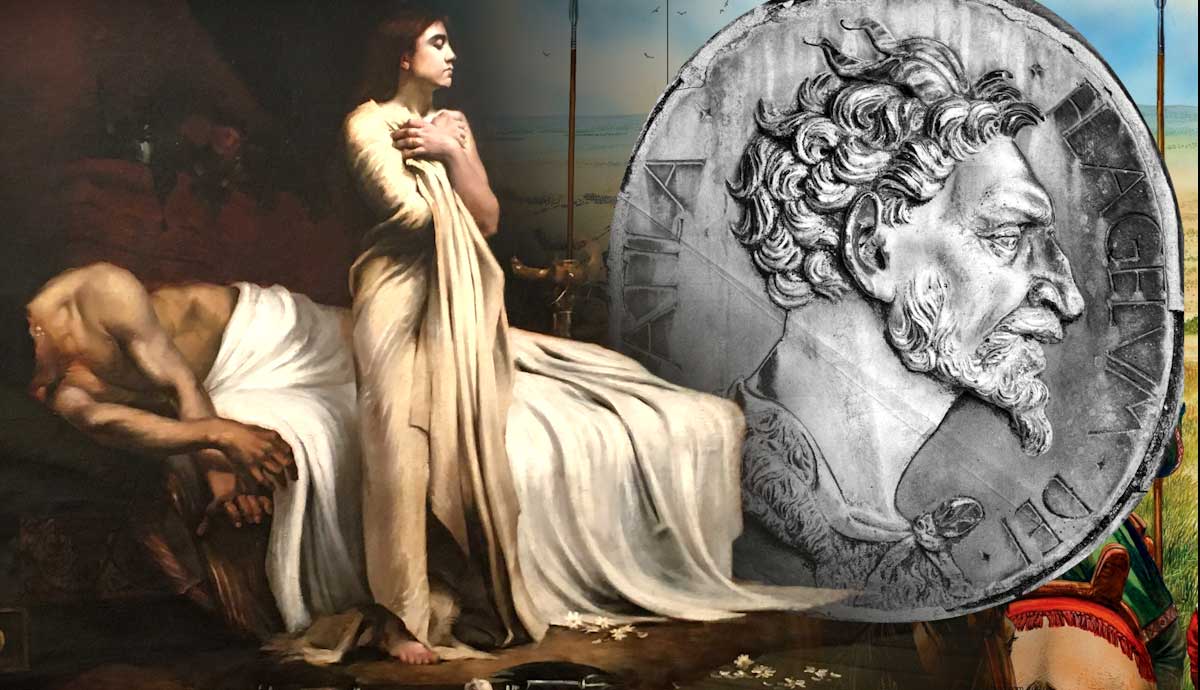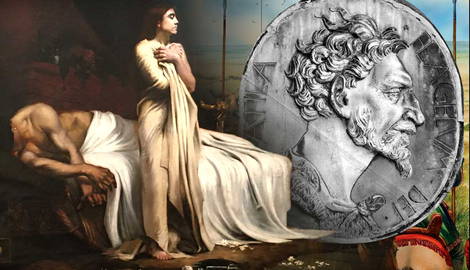
Attila the Hun is one of the few names from antiquity that prompts instant recognition, along with Alexander the Great, Hannibal, Cleopatra, and Nero. He is widely considered “the barbarian” of the ancient world. After all, this man was called flagellum Dei – the Scourge of God.
In the mid-5th century CE, Attila ruled over a vast Eurasian Empire. The fear he instilled lingered for centuries. Medieval artists stressed Attila’s inhumanity, depicting the Hunnic leader with a goatish beard and devil’s horns.
For Enlightenment historian Edward Gibbon, Attila was a “savage destroyer” of whom it was said, “the grass never grew on the spot where his horse had trod.” During the Great War, the British emphasized the “otherness” of their opponents, by calling them “Huns.” Recently, however, historians have reconsidered Attila’s life and reign, giving us a more nuanced perspective on the man “born into the world to shake nations.”
1. Attila the Hun Came from a Privileged and Educated Background

Far from the stereotype of the unwashed, uneducated barbarian, Attila the Hun was born into one of the most powerful families on the northern bank of the Danube River. His uncles — Rugila and Octar — jointly ruled the Hun Empire in the mid-fifth century CE. As members of the Hunnic nobility, both Attila and his brother Bleda were trained in archery, sword-fighting, and, most notably, for a Hun, horse-riding. The Huns were renowned for their ability to shoot arrows accurately from horseback during battle.
Interestingly, both brothers spoke (and possibly read) Gothic and Latin, the latter being the lingua franca of the weakened but still formidable Roman Empire. They also got an education in the art of diplomacy. Both Attila and Bleda were present when the Hunnic kings hosted Roman ambassadors. One of them was Priscus, who left us the most reliable account of the Huns. Among the Romans present at the Hunnic court was future general Aetius, who had spent his youth as a hostage with the Huns and had grown up with Attila.
2. Initially, Attila Was a Roman Ally

Following the deaths of their uncles in 434, Bleda and Attila inherited joint control over the Hun Empire. Unlike their predecessors, who waged a series of wars against the Roman Empire, the new rulers negotiated a treaty with the emperor in Constantinople. Emperor Theodosius II agreed to pay around 700 pounds of gold annually to keep the peace between the Huns and the Romans. However, only a few years later, Attila resumed hostilities, claiming that the Romans had violated the treaty.
Exploiting the absence of Roman border troops sent to fight the Vandals, Attila crossed the Danube, advancing deep into imperial territory. The city of Naissus (modern-day Niš), the birthplace of emperor Constantine the Great, was razed and remained in ruins for centuries afterward. Once again, Theodosius was forced to sue for peace, paying Attila the staggering sum of 2100 pounds of gold per year (!).
While Attila waged war against Constantinople, his relations with the Western Roman Empire were more amicable. In fact, for more than a decade, the Huns were close allies of the Roman general Flavius Aetius. Aetius, who had previously been a hostage of the Huns, used Hunnic horse-riders to suppress threats from internal revolts and hostile Germanic tribes, such as the Franks, Visigoths, and Burgundians. As a result, with the help of the Huns, Aetius managed to stabilize Roman control over Gaul (modern-day France). In turn, those victories solidified Aetius’ control over the Western Roman army, making him the emperor in all but name.
3. His brother Died a Mysterious Death

Not much is known about the relationship between Attila the Hun and his brother Bleda. They seem to have tolerated each other, jointly ruling over the Hun Empire for over a decade. They led their warriors on raids against Sassanid Persia and the Roman Empire. In 443, unable to take Constantinople, the Hunnic kings made peace with Theodosius II and withdrew back to the Pannonian plain.
The details are hazy, but in 445, Bleda was dead. We do not know how he met his end. According to classical sources, however, Bleda probably fell victim to his brother’s ambition. Priscus, the Roman historian, and diplomat who visited the Hunnic court on several occasions, blamed Attila for Bleda’s death. Perhaps Bleda opposed Attila’s war with the Romans. Two years after his brother’s mysterious death, Attila led another attack on the Eastern Roman Empire. The Huns stormed through the Balkans and went as far as Greece until the imperial forces managed to stop them at Thermopylae. Once again, the Romans had to sue for peace, on even harsher terms.
4. Attila the Hun Invaded Gaul to Win Himself a Wife

While the Eastern Roman Empire was a prime target for extortion, the imperial resistance had become more organized. In addition, Constantinople remained an insurmountable obstacle for the Huns. Even Hunnic siege engines could not break the Theodosian Walls. Attila now turned his eyes towards the Western Roman Empire. Attila had evidently planned such a move for some time, but his raids were officially provoked after he received a letter from Honoria, the sister of Emperor Valentinian III. According to seventh-century historian John of Antioch, Honoria sent a love letter to Attila, accompanied by a ring, asking the Hunnic leader to get her out of a bad marriage.
Attila used this flimsy pretext to invade the West, claiming that he had come to get his bride and that half of the Western Roman Empire was her rightful dowry. In spring 451, Attila crossed the Rhine River and advanced into Gaul at the head of the vast army. The Roman legions were occupied elsewhere and offered only token resistance. The Huns ravaged Gaul, using the siege weaponry to take many huge well-defended cities, including the former imperial capital of Trier. It remains unclear why Attila changed his strategy so suddenly. It may be that to stay in power; he required a major demonstration of strength. Alternatively, it may be that he felt that the emperor in Ravenna simply had not paid him enough respect (or gold).
5. Attila Suffered His First, and Only Defeat, at the Battle of the Catalaunian Plains

Whatever the reason, Attila’s Huns ravaging Gaul gave a major headache to his former friend, ally, and de-facto ruler of the Roman West, Flavius Aetius. As the imperial army alone could not halt the Huns, Aetius made a deal with the devil. He formed an alliance with Theodoric I, the king of the Visigoths, whom Aetius had fought and defeated with Hunnic help only a few years ago. The joint Roman-Visigoth army intercepted Attila’s forces while approaching Orleans, forcing the enemy into a pitched battle.
The Battle of Catalaunian Plains, also known as the Battle of Chalons, was a messy affair. Both sides suffered huge losses, but it seems that the Romans were victorious in the end. Aetius had a reason to celebrate. Not only had he defeated Attila, but his rival/ally Theodoric perished in the battle. Interestingly, the Romans allowed Attila to flee the battlefield. It is unclear why. Perhaps Aetius felt that the Huns may yet prove useful to him. Theodoric was dead, but without the Hunnic menace, the Visigoths could again become a danger to Roman control of Gaul and Aetius’ position at court.
6. Attila’s Last Battle

Aetius’ plan ultimately backfired. Attila’s ambition was more than a simple personal affair. For Attila, raids against the Romans were a political necessity. To keep his warriors happy, he needed the loot and the “gifts.” At first, this meant raids, then war, and as his empire grew, a full-scale conquest. Perhaps Attila felt that marriage to Honoria, a member of the imperial family, would make him eligible for the throne? His victory in Gaul would also undermine Aetius’ position at the court, allowing Attila to take the place of the Roman commander.
But his next move shocked the Romans. In 452, Attila returned with an even larger army, this time striking deep into northern Italy, and aiming for Rome itself. The Hunnic army was now in the imperial heartland, and Aetius was powerless to stop them. After taking a dozen cities in the Po valley, including Aquileia, and the old western capital of Milan, the Huns halted their advances, not because of military defeat but because of disease and famine. Following a meeting with Pope Leo the Great, Attila turned back and retreated to Pannonia for the last time.
7. Attila Died Horribly (and Mysteriously) on His Wedding Night

The retreat from Italy marked the beginning of the end for Attila the Hun. In 453, while he was planning a new attack on the Eastern Roman Empire and its new emperor Marcian, Attila decided to take a new wife. Her name was Ildico, and she was probably a Germanic princess. However, on their wedding night, a tragedy occurred. The historian Jordanes tells us Attila suffered a seizure after “giving himself to excessive joy.” In the morning, appalled attendants found Attila dead, with a weeping young woman at his bedside.
Some suggested that Ildico played a part in his death or that he fell victim to a conspiracy engineered by Marcian; others dismissed it as a freak accident or a cautionary tale about the dangers of binge drinking. The most probable explanation is that the veins in Attila’s throat, enlarged by years of drinking, burst. Thus, Attila choked to death on his own blood. Attila’s death deprived the Huns of a great and charismatic leader. Within a few years, the Hunnic empire had disintegrated. The Western Roman Empire soon followed, with the fall of Rome in 476.
8. Attila the Hun’s Burial Site Remains a Secret

According to Priscus, the sudden death of the Hunnic leader was followed by a day of grief, feasting, and funeral games. Attila’s body was encased in three coffins: the innermost covered in gold, a second in silver, and a third in iron. The gold and silver symbolized the plunder Attila had seized from the Romans, while the gray iron recalled his victory in war. Then, under cover of darkness, Attila was buried in secrecy.
According to legend, the Huns diverted a river, buried Attila, and then allowed the river to run its course. Nothing was left to chance. Those who had taken part in the funeral were killed, leaving no witnesses for the location of the Attila the Hun’s burial site. However, it is hard to say how reliable this account is. Attila’s tomb has never been found and remains a secret today.










